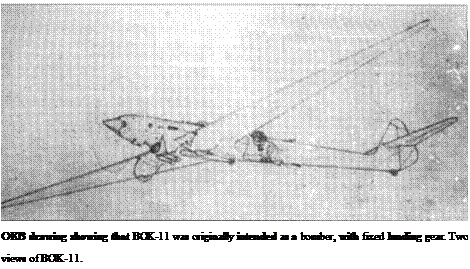BOK-8
Purpose: To devise an armament system for the BOK-11.
Design Bureau: Bureau of Special Design, Smolensk.
In 1937 the BOK began work on the BOK-11 (see below) and decided that it should have defensive armament. The BOK-8 was schemed to test this armament. Design was entrusted to BOK engineers V S Kostyshkin and K B Zhbanov. The complete installation was on test by December 1939. Few details have survived, and the aircraft never flew.
The armament system comprised two power-driven barbettes or turrets each housing guns (one report says cannon but Shavrov says ‘machine guns’) outside the pressure cabin, aimed by a synchronous tracking system with thyratron servo control. The gunner, to have been the third member of the BOK-11 crew, had a Rezunov optical sight system, and the guns were slaved to follow the sightline to the target. Shavrov comments that this system was tested three years before a similar scheme was devised for the Boeing B-29.
The armament scheme was never fitted to the BOK-11 for reasons given in the description of that aircraft.
No data.
BOK-11
Purpose: Strategic reconnaissance.
Design Bureau: Bureau of Special Design, Smolensk. Chief designer Chizhevskii.
Having created aircraft with impressive range and high-altitude capability it was logical to go on and derive an aircraft able to fly with impunity for great distances over hostile territory carrying long-focus cameras. After argument it was decided to make this aircraft a three – seater, the third man being a gunner controlling the defensive system tested with the BOK-8. Design began in 1938. Two BOK-11 prototypes were ordered, and the first was flown in 1940. However, in 1938 Chizhevskii and several of his colleagues had been arrested (as was Filin soon after, see BOK-7), and this put the whole of BOK’s operations under a cloud. As with many programmes at this time of terror, nobody wanted to do anything that might lead to any kind of failure. So, even though the first BOK-11 was delivered to the NIl-WS (where its official walk-round photographs were taken on 4th November 1940), test flying was soon abandoned. There seems little doubt that reports of the ‘BOK-15’ really refer to the BOK-11, in which case, for Nil testing, the Nol aircraft was assigned to A B Yumashev and the No 2 to G F Baidukov.
In general the BOK-1 Is were similar to the BOK-7, apart from having the massive 1,500hp Charomskii ACh-40 diesel engine to give increased range. The large radiator was in a duct under the leading edge. Each of the long-span ailerons had two mass-balances on its underside, the tailplane was wire – braced, and the elevators and tabbed rudder were fabric-covered. The armament system and gunner station were never installed.
There is no reason to doubt that a properly developed BOK-11 could have given the Soviet Union a strategic-reconnaissance capability considerably better than that of any other country. As noted under the BOK-7, the atmosphere of fear in 1940 led to this programme being abandoned.
 Dimensions
Dimensions
Span 34.0m Illft63/4in
Length 12.9m 42 ft 4 in
Wing area 87m2 936.5ft2
4,090 kg 9,01 7 Ib
10,000kg 22,046 Ib
252 knYh 157 mph
|











